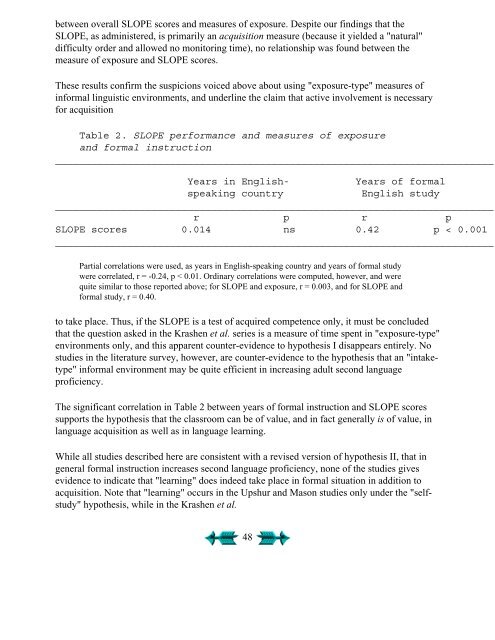Second Language Acquisition and Second ... - Stephen Krashen
Second Language Acquisition and Second ... - Stephen Krashen
Second Language Acquisition and Second ... - Stephen Krashen
Create successful ePaper yourself
Turn your PDF publications into a flip-book with our unique Google optimized e-Paper software.
etween overall SLOPE scores <strong>and</strong> measures of exposure. Despite our findings that the<br />
SLOPE, as administered, is primarily an acquisition measure (because it yielded a "natural"<br />
difficulty order <strong>and</strong> allowed no monitoring time), no relationship was found between the<br />
measure of exposure <strong>and</strong> SLOPE scores.<br />
These results confirm the suspicions voiced above about using "exposure-type" measures of<br />
informal linguistic environments, <strong>and</strong> underline the claim that active involvement is necessary<br />
for acquisition<br />
Table 2. SLOPE performance <strong>and</strong> measures of exposure<br />
<strong>and</strong> formal instruction<br />
_________________________________________________________________________<br />
Years in English- Years of formal<br />
speaking country English study<br />
_________________________________________________________________________<br />
r p r p<br />
SLOPE scores 0.014 ns 0.42 p < 0.001<br />
_________________________________________________________________________<br />
Partial correlations were used, as years in English-speaking country <strong>and</strong> years of formal study<br />
were correlated, r = -0.24, p < 0.01. Ordinary correlations were computed, however, <strong>and</strong> were<br />
quite similar to those reported above; for SLOPE <strong>and</strong> exposure, r = 0.003, <strong>and</strong> for SLOPE <strong>and</strong><br />
formal study, r = 0.40.<br />
to take place. Thus, if the SLOPE is a test of acquired competence only, it must be concluded<br />
that the question asked in the <strong>Krashen</strong> et al. series is a measure of time spent in "exposure-type"<br />
environments only, <strong>and</strong> this apparent counter-evidence to hypothesis I disappears entirely. No<br />
studies in the literature survey, however, are counter-evidence to the hypothesis that an "intaketype"<br />
informal environment may be quite efficient in increasing adult second language<br />
proficiency.<br />
The significant correlation in Table 2 between years of formal instruction <strong>and</strong> SLOPE scores<br />
supports the hypothesis that the classroom can be of value, <strong>and</strong> in fact generally is of value, in<br />
language acquisition as well as in language learning.<br />
While all studies described here are consistent with a revised version of hypothesis II, that in<br />
general formal instruction increases second language proficiency, none of the studies gives<br />
evidence to indicate that "learning" does indeed take place in formal situation in addition to<br />
acquisition. Note that "learning" occurs in the Upshur <strong>and</strong> Mason studies only under the "selfstudy"<br />
hypothesis, while in the <strong>Krashen</strong> et al.<br />
48











